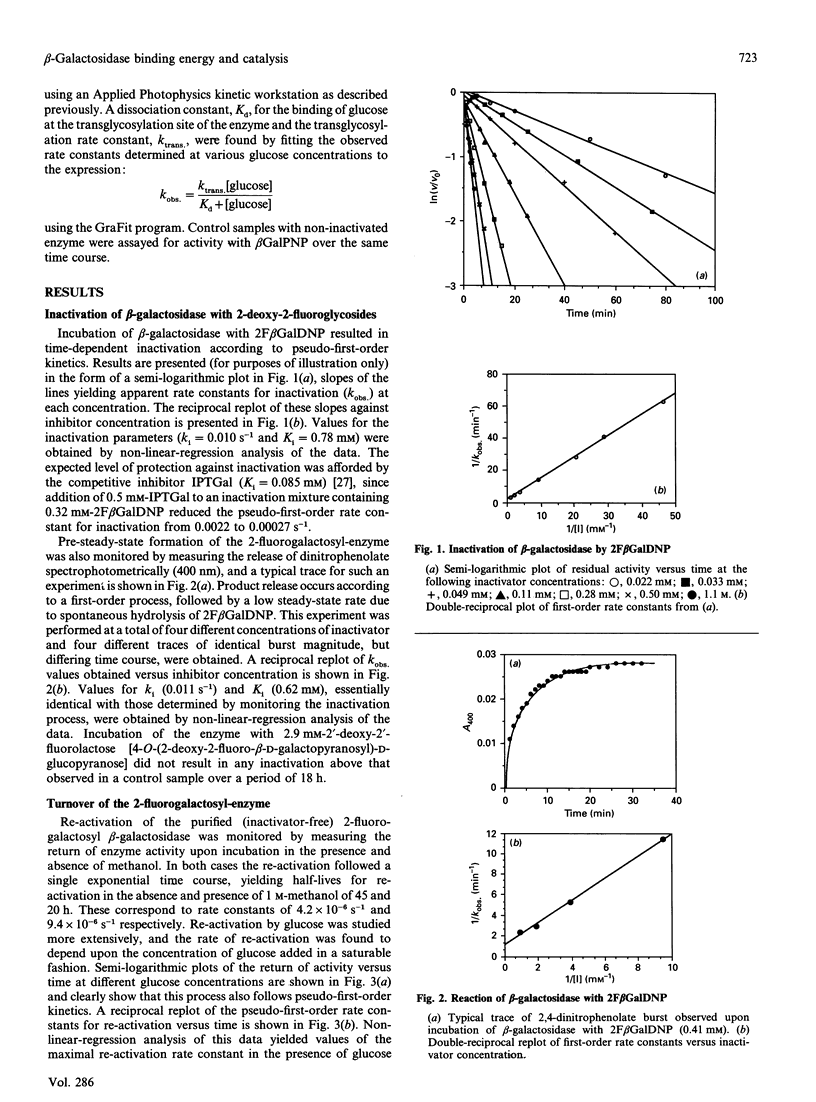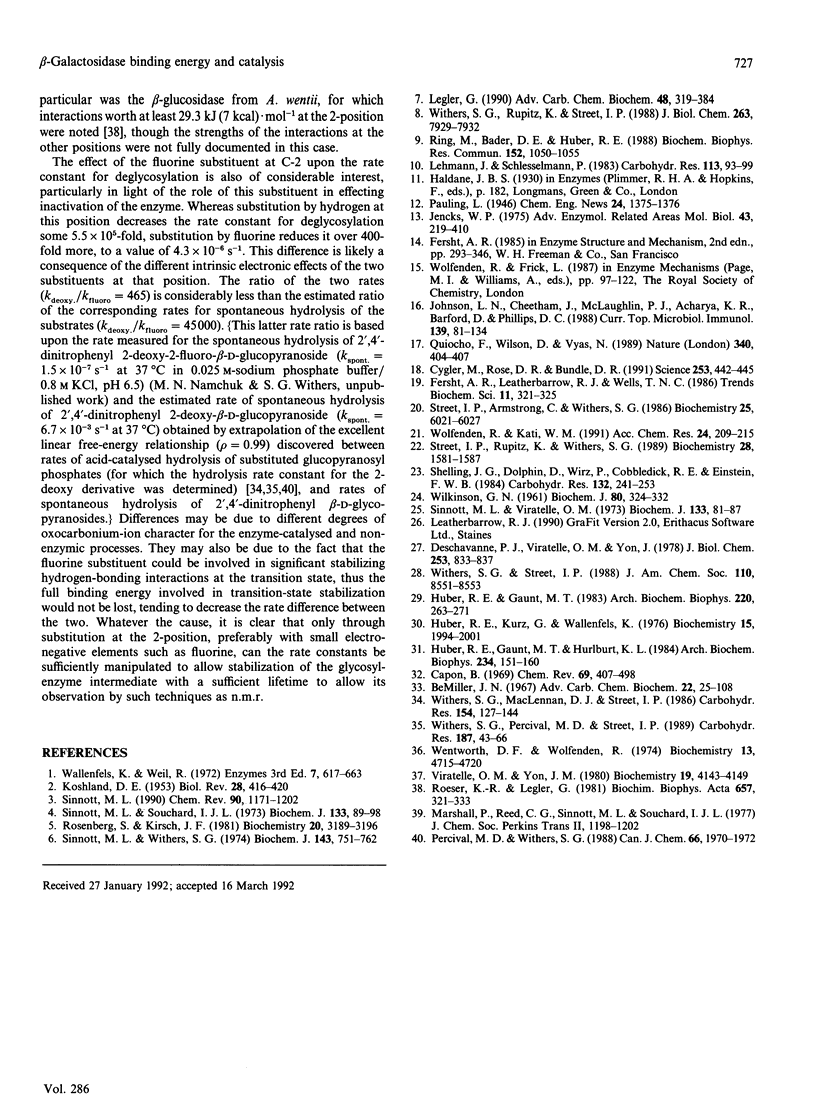Abstract
Kinetic parameters for the hydrolysis of a series of deoxy and deoxyfluoro analogues of 2',4'-dinitrophenyl beta-D-galactopyranoside by Escherichia coli (lacZ) beta-galactosidase have been determined and rates found to be two to nine orders of magnitude lower than that for the parent compound. These large rate reductions result primarily from the loss of transition-state binding interactions due to the replacement of sugar hydroxy groups, and such interactions are estimated to contribute at least 16.7 kJ (4 kcal).mol-1 to binding at the 3, 4 and 6 positions and more than 33.5 kJ (8 kcal).mol-1 at the 2 position. The existence of a linear free-energy relationship between log(kcat./Km) for these compounds and the logarithm of the first-order rate constant for their spontaneous hydrolysis demonstrates that electronic effects are also important and provides direct evidence for oxocarbonium ion character in the enzymic transition state. A covalent intermediate which turns over only extremely slowly (t1/2 = 45 h) accumulates during hydrolysis of the 2-deoxyfluorogalactoside, and kinetic parameters for its formation have been determined. This intermediate is nonetheless catalytically competent, since it re-activates much more rapidly in the presence of the transglycosylation acceptors methanol or glucose, thereby providing support for the notion of a covalent intermediate during hydrolysis of the parent substrates.
Full text
PDF






Selected References
These references are in PubMed. This may not be the complete list of references from this article.
- BeMiller J. N. Acid-catalyzed hydrolysis of glycosides. Adv Carbohydr Chem Biochem. 1967;22:25–108. doi: 10.1016/s0096-5332(08)60151-4. [DOI] [PubMed] [Google Scholar]
- Cygler M., Rose D. R., Bundle D. R. Recognition of a cell-surface oligosaccharide of pathogenic Salmonella by an antibody Fab fragment. Science. 1991 Jul 26;253(5018):442–445. doi: 10.1126/science.1713710. [DOI] [PubMed] [Google Scholar]
- Deschavanne P. J., Viratelle O. M., Yon J. M. Conformational adaptability of the active site of beta-galactosidase. Interaction of the enzyme with some substrate analogous effectors. J Biol Chem. 1978 Feb 10;253(3):833–837. [PubMed] [Google Scholar]
- Huber R. E., Gaunt M. T., Hurlburt K. L. Binding and reactivity at the "glucose" site of galactosyl-beta-galactosidase (Escherichia coli). Arch Biochem Biophys. 1984 Oct;234(1):151–160. doi: 10.1016/0003-9861(84)90336-9. [DOI] [PubMed] [Google Scholar]
- Huber R. E., Gaunt M. T. Importance of hydroxyls at positions 3, 4, and 6 for binding to the "galactose" site of beta-galactosidase (Escherichia coli). Arch Biochem Biophys. 1983 Jan;220(1):263–271. doi: 10.1016/0003-9861(83)90409-5. [DOI] [PubMed] [Google Scholar]
- Huber R. E., Kurz G., Wallenfels K. A quantitation of the factors which affect the hydrolase and transgalactosylase activities of beta-galactosidase (E. coli) on lactose. Biochemistry. 1976 May 4;15(9):1994–2001. doi: 10.1021/bi00654a029. [DOI] [PubMed] [Google Scholar]
- Jencks W. P. Binding energy, specificity, and enzymic catalysis: the circe effect. Adv Enzymol Relat Areas Mol Biol. 1975;43:219–410. doi: 10.1002/9780470122884.ch4. [DOI] [PubMed] [Google Scholar]
- Johnson L. N., Cheetham J., McLaughlin P. J., Acharya K. R., Barford D., Phillips D. C. Protein-oligosaccharide interactions: lysozyme, phosphorylase, amylases. Curr Top Microbiol Immunol. 1988;139:81–134. doi: 10.1007/978-3-642-46641-0_4. [DOI] [PubMed] [Google Scholar]
- Legler G. Glycoside hydrolases: mechanistic information from studies with reversible and irreversible inhibitors. Adv Carbohydr Chem Biochem. 1990;48:319–384. doi: 10.1016/s0065-2318(08)60034-7. [DOI] [PubMed] [Google Scholar]
- Quiocho F. A., Wilson D. K., Vyas N. K. Substrate specificity and affinity of a protein modulated by bound water molecules. Nature. 1989 Aug 3;340(6232):404–407. doi: 10.1038/340404a0. [DOI] [PubMed] [Google Scholar]
- Ring M., Bader D. E., Huber R. E. Site-directed mutagenesis of beta-galactosidase (E. coli) reveals that tyr-503 is essential for activity. Biochem Biophys Res Commun. 1988 May 16;152(3):1050–1055. doi: 10.1016/s0006-291x(88)80390-5. [DOI] [PubMed] [Google Scholar]
- Roeser K. R., Legler G. Role of sugar hydroxyl groups in glycoside hydrolysis. Cleavage mechanism of deoxyglucosides and related substrates by beta-glucosidase A3 from Aspergillus wentii. Biochim Biophys Acta. 1981 Feb 13;657(2):321–333. doi: 10.1016/0005-2744(81)90318-1. [DOI] [PubMed] [Google Scholar]
- Rosenberg S., Kirsch J. F. Oxygen-18 leaving group kinetic isotope effects on the hydrolysis of nitrophenyl glycosides. 1. beta-galactosidease-catalyzed hydrolysis. Biochemistry. 1981 May 26;20(11):3189–3196. doi: 10.1021/bi00514a031. [DOI] [PubMed] [Google Scholar]
- Sinnott M. L., Souchard I. J. The mechanism of action of beta-galactosidase. Effect of aglycone nature and -deuterium substitution on the hydrolysis of aryl galactosides. Biochem J. 1973 May;133(1):89–98. doi: 10.1042/bj1330089. [DOI] [PMC free article] [PubMed] [Google Scholar]
- Sinnott M. L., Viratelle O. M. The effect of methanol and dioxan on the rates of the beta-galactosidase-catalysed hydrolyses of some beta-D-galactrophyranosides: rate-limiting degalactosylation. The ph-dependence of galactosylation and degalactosylation. Biochem J. 1973 May;133(1):81–87. doi: 10.1042/bj1330081. [DOI] [PMC free article] [PubMed] [Google Scholar]
- Sinnott M. L., Withers S. G. The beta-galactosidase-catalysed hydrolyses of beta-d-galactopyranosyl pyridium salts. Rate-limiting generation of an enzyme-bound galactopyranosyl cation in a process dependent only on aglycone acidity. Biochem J. 1974 Dec;143(3):751–762. doi: 10.1042/bj1430751. [DOI] [PMC free article] [PubMed] [Google Scholar]
- Street I. P., Armstrong C. R., Withers S. G. Hydrogen bonding and specificity. Fluorodeoxy sugars as probes of hydrogen bonding in the glycogen phosphorylase-glucose complex. Biochemistry. 1986 Oct 7;25(20):6021–6027. doi: 10.1021/bi00368a028. [DOI] [PubMed] [Google Scholar]
- Street I. P., Rupitz K., Withers S. G. Fluorinated and deoxygenated substrates as probes of transition-state structure in glycogen phosphorylase. Biochemistry. 1989 Feb 21;28(4):1581–1587. doi: 10.1021/bi00430a024. [DOI] [PubMed] [Google Scholar]
- Viratelle O. M., Yon J. M. Comparison of the beta-galactosidase conformations induced by D-galactal and by magnesium ions. Biochemistry. 1980 Sep 2;19(18):4143–4149. doi: 10.1021/bi00559a002. [DOI] [PubMed] [Google Scholar]
- WILKINSON G. N. Statistical estimations in enzyme kinetics. Biochem J. 1961 Aug;80:324–332. doi: 10.1042/bj0800324. [DOI] [PMC free article] [PubMed] [Google Scholar]
- Wentworth D. F., Wolfenden R. Slow binding of D-galactal, a "reversible" inhibitor of bacterial beta-galactosidase. Biochemistry. 1974 Nov 5;13(23):4715–4720. doi: 10.1021/bi00720a006. [DOI] [PubMed] [Google Scholar]
- Withers S. G., Rupitz K., Street I. P. 2-Deoxy-2-fluoro-D-glycosyl fluorides. A new class of specific mechanism-based glycosidase inhibitors. J Biol Chem. 1988 Jun 15;263(17):7929–7932. [PubMed] [Google Scholar]


